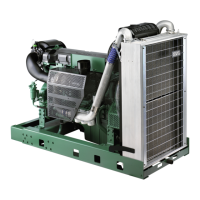Do you have a question about the Volvo Penta TAD1642GE-B and is the answer not in the manual?
Perform visual checks on the engine before and after operation.
Use appropriate personal protective equipment for safety.
Wear safety glasses to protect eyes from hazards.
Take precautions to protect skin from oil and chemicals.
Follow fire and explosion prevention measures.
Use genuine Volvo Penta spare parts for safety and reliability.
Handle and dispose of used oils and chemicals properly.
Follow pre-start checks for safety and engine integrity.
Stop engine and disconnect power before electrical work.
Caution with hot coolant and oil under pressure to prevent burns.
Follow refueling safety and use recommended fuel.
Prevent fire and explosion hazards around batteries.
Do not use a high-pressure washer for engine cleaning.
This manual contains information for safe operation and maintenance.
Proper procedure for the first 10 operating hours.
Use recommended fuels and oils; follow maintenance intervals.
Maintain reliability with genuine parts and regular servicing.
Volvo Penta engines are designed for low emissions and efficiency.
Special demands for emission-certified engines.
Information on authorized dealers and action service.
Overview of industrial diesel engines covered by the manual.
Electronic system for engine control, fuel regulation, and diagnostics.
Optional accessory for EMS with engine control functions.
Instructions for starting the engine using the DCU panel buttons.
Navigating the DCU menu structure and viewing engine data.
Using functions like Preheat, Governor, Diagnostics, and Trip reset.
Configuring engine parameters and settings for Versatile applications.
Setting parameters for Gen Set applications and throttle control.
Adjusting display settings and viewing system information.
Overview of the DCU II instrument panel functions.
Understanding DCU II display menus, status bar, and alarm types.
Accessing detailed engine data, diagnostics, and system settings.
Navigating menus for units, alarms, language, and system.
Interface unit and available instruments for engine monitoring.
Pre-start checks for oil, fuel, coolant, and power.
Avoid using start spray to prevent explosion risk.
Procedure for starting the engine with or without pre-heating.
Preparations for starting the engine in extreme cold conditions.
Procedure for starting the engine with auxiliary batteries.
Checking engine instruments during and after operation.
Understanding engine alarms and fault codes from EMS.
Guidance on maneuvering the engine and avoiding low load operation.
Recommendations to avoid malfunctions from low load operation.
Procedure before shutting down the engine for normal use.
Steps to properly stop the engine using the control panel.
Location and function of the auxiliary stop control.
Checks and actions after shutting down the engine.
Recommended procedures for extended engine stoppage.
Purpose of the diagnostic function for monitoring and protection.
Reading and interpreting fault codes on the DCU.
Understanding DU display fault pop-ups and messages.
Reading fault codes via CIU diagnostic lamp and Easy Link instruments.
Procedure for resetting fault codes.
Table of symptoms and possible causes for engine malfunctions.
Detailed list of causes for various engine malfunctions.
Register of fault codes, components, and FMI codes.
Overview of recommended service intervals.
Conditions for extending service intervals.
Performing visual checks on the engine and compartment.
Procedure for checking and replacing the air filter.
Identification of key engine components for various models.
Checking the charge air hoses for leaks and damage.
Inspecting drive and alternator belts for wear and tension.
Step-by-step guide to changing the drive belt.
Procedure for replacing the alternator belt.
Information on oil change intervals and recommendations.
Procedure for checking and maintaining correct engine oil level.
Steps for changing the engine oil and filters.
Procedure for changing oil and by-pass filters.
Safety precautions and recommendations for the fuel system.
Procedure for draining condensate from the fuel pre-filter.
Steps for replacing the engine fuel filter.
Procedure for changing the fuel pre-filter and water trap.
Procedure for bleeding the fuel system.
Information on the cooling system and coolant requirements.
Recommendations for mixing coolant and water.
Procedure for checking and topping up coolant level.
Procedure for filling and venting an empty cooling system.
Procedure for draining the engine cooling system.
Instructions for cleaning the charge air cooler.
Procedure for cleaning the engine cooling system.
Installation, removal, and cleaning of the cooling air filter.
Overview of the engine's electrical system.
Information and warnings regarding the main switch.
Safety precautions and maintenance for batteries.
Procedures for disconnecting and connecting batteries.
Recommended actions to increase battery service life.
Important points for conserving the engine for long periods.
Procedures for preparing the engine after storage.
Conserving lubrication and fuel systems for extended periods.
Specifications for various engine models.
Oil change volumes, pressure, and recommendations.
Selecting oil viscosity based on temperature.
Fuel system specifications, general requirements, and restrictions.
Information on paraffinic and biodiesel fuels and service requirements.
Cooling system pressure and volume specifications.
Recommendations for mixing coolant and water quality.
System voltage, alternator specs, and battery capacity.
Location of engine labels and identification numbers.
Declaration according to Machinery Directive 2006/42/EC.
| Brand | Volvo Penta |
|---|---|
| Model | TAD1642GE-B |
| Category | Engine |
| Language | English |











